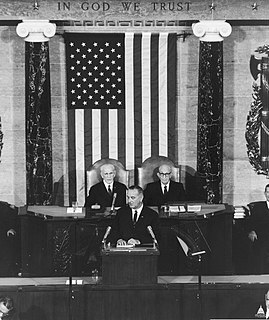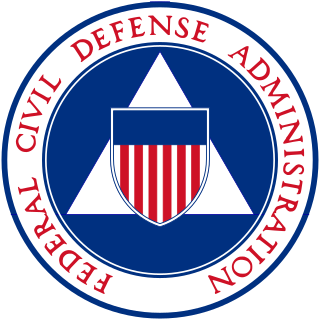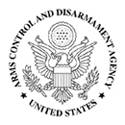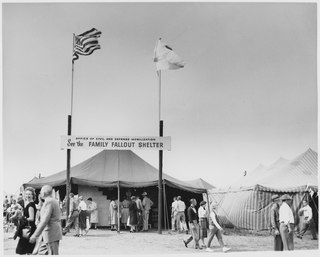
The Farm Credit Administration is an independent agency of the federal government of the United States. Its function is to regulate the financial institutions that provide credit to farmers.

The Mutual Security Act of 1951 launched a major American foreign aid program, 1951–61, of grants to numerous countries. It largely replaced the Marshall Plan. The main goal was to help poor countries develop and to contain the spread of communism. It was signed on October 10, 1951, by President Harry S. Truman. Annual authorizations were about $7.5 billion, out of a GDP of $340bn in 1951, for military, economic, and technical foreign aid to American allies. The aid was aimed primarily at shoring up Western Europe, as the Cold War developed. In 1961 it was replaced by a new foreign aid program, the Foreign Assistance Act of 1961, which created the Agency for International Development (AID), and focused more on Latin America.

The Johnson Doctrine, enunciated by U.S. President Lyndon B. Johnson after the United States' intervention in the Dominican Republic in 1965, declared that domestic revolution in the Western Hemisphere would no longer be a local matter when the object is the establishment of a "Communist dictatorship". It is an extension of the Eisenhower and Kennedy doctrines.

The Federal Civil Defense Administration (FCDA) was organized by President Harry S. Truman on December 1, 1950, through Executive Order 10186, and became an official government agency via the Federal Civil Defense Act of 1950 on 12 January 1951. In 1958 the FCDA was superseded by the Office of Civil and Defense Mobilization when President Dwight D. Eisenhower merged the FCDA with the Office of Defense Mobilization.

The U.S. Arms Control and Disarmament Agency (ACDA) was an independent agency of the United States government that existed from 1961 to 1999. Its mission was to strengthen United States national security by "formulating, advocating, negotiating, implementing and verifying effective arms control, nonproliferation, and disarmament policies, strategies, and agreements."
The Office of War Mobilization (OWM) was an independent agency of the United States government formed during World War II to coordinate all government agencies involved in the war effort. It was formed on May 27, 1943 by Executive Order 9347.

The Office of Civil Defense (OCD) was an agency of the United States Department of Defense from 1961–64. It replaced the Office of Civil and Defense Mobilization. The organization was renamed the Defense Civil Preparedness Agency on May 5, 1972, and was abolished on July 20, 1979, pursuant to Executive Order 12148. Its duties were given to the Federal Emergency Management Agency (FEMA).
The Wage Stabilization Board (WSB) was an independent agency of the United States government whose function was to make wage control policy recommendations and to implement such wage controls as were approved. There were two agencies with the same name. The first, the National Wage Stabilization Board, was the successor to the National War Labor Board, and existed from January 1, 1946, to February 24, 1947. The second, the Wage Stabilization Board, was a part of the Office of Defense Mobilization and existed from September 9, 1950, to February 6, 1953.
The Foreign Operations Administration was created in 1953 under the directorship of Harold Stassen. Its purpose "was intended to centralize all governmental operations, as distinguished from policy formulation, that had as their purpose the cooperative development of economic and military strength among the nations of the free world". It was abolished by Executive Order 10610 on May 9, 1955. Its functions were split and transferred to the United States Department of State and the United States Department of Defense.
The Office of Economic Stabilization was established within the United States Office for Emergency Management on October 3, 1942, pursuant to the Stabilization Act of 1942, as a means to control inflation during World War II through regulations on price, wage, and salary increases.

Donald Randall Richberg was an American attorney, civil servant, and author who was one of President Franklin D. Roosevelt's key aides and who played a critical role in the New Deal. He co-wrote the National Industrial Recovery Act, was general counsel and executive director of the National Recovery Administration. He also co-authored the Railway Labor Act, the Norris-LaGuardia Act, and the Taft-Hartley Act.
The Federal Works Agency (FWA) was an independent agency of the federal government of the United States which administered a number of public construction, building maintenance, and public works relief functions and laws from 1939 to 1949. Along with the Federal Security Agency and Federal Loan Agency, it was one of three catch-all agencies of the federal government pursuant to reorganization plans authorized by the Reorganization Act of 1939, the first major, planned reorganization of the executive branch of the government of the United States since 1787.

The War Powers Act of 1941, also known as the First War Powers Act, was an American emergency law that increased Federal power during World War II. The act was signed by U.S. President Franklin D. Roosevelt and put into law on December 18, 1941, less than two weeks after the Japanese attack on Pearl Harbor. The act was similar to the Departmental Reorganization Act of 1917 as it was signed shortly before the U.S. engaged in a large war and increased the powers of the president's U.S. Executive Branch.
Many countries around the world have civil defense organizations dedicated to protecting civilians from military attacks and providing rescue services after widespread disasters. In most countries, civil defense is a government-managed and often volunteer-staffed organization.

The Displaced Persons Act of 1948 authorized for a limited period of time the admission into the United States of 200,000 certain European displaced persons (DPs) for permanent residence.

The Office of Civil and Defense Mobilization, created in 1958 originally as Office of Defense and Civilian Mobilization, was an office of the Executive Office of the President of the United States which consolidated the functions of the existing Office of Defense Mobilization and the Federal Civil Defense Administration. The civil defense functions of the office were transferred to the Department of Defense's Office of Civil Defense from August 1, 1961. With its remaining functions, the office was re-designated as the Office of Emergency Planning from September 22, 1961. It eventually was renamed the Office of Emergency Preparedness from October 21, 1968, and abolished on July 1, 1973.
The Mutual Security Agency (1951–1953) was a US agency to strengthen European allies of World War II through military assistance and economic recovery.

Passport Act of 1926, 22 U.S.C § 211, is a United States statue authorizing the issuance of United States passports and visas for a validity of two years from the issue date. The Act of Congress provided the United States Department of State authority to limit the validity of a passport or visa in accordance with the Immigration Act of 1924.
The National War Labor Board, commonly the War Labor Board was an agency of the United States government established January 12, 1942 by executive order to mediate labor disputes during World War II.

Passport Act of 1920 or Passport Control Act, 1920 was a federal statute authored by the United States 66th Congress. The legislation was an appropriations bill authorizing a fiscal policy for the United States Diplomatic and Consular Service.









